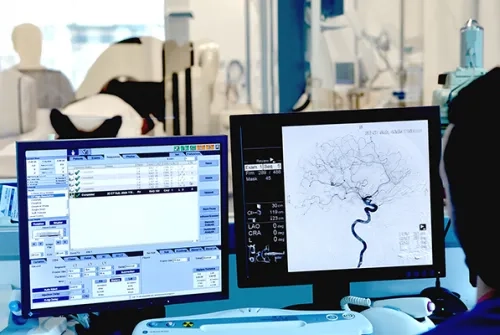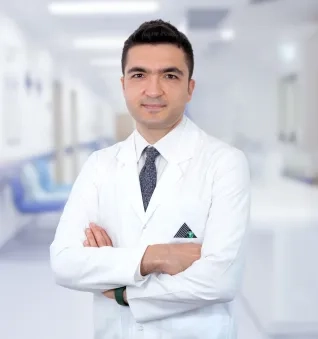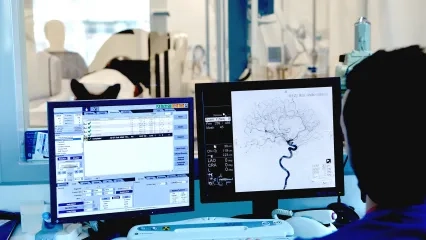Alo Yeditepe
Alo Yeditepe
Diagnosis and Treatment of Acute Stroke
Acute stroke, which is one of the most important causes of disabilities in the adult population in our country and the world, dependent living, labor force, and more importantly loss of life, can be treated intravenously without surgery with interventional radiological methods. Interventional Radiology Specialist Assoc. Prof. Dr. Melih Topcuoğlu stated that interventional methods are a very important emergency in preventing medical and socioeconomic negative consequences due to acute stroke and acute stroke.
Acute stroke, commonly known as paralysis, is defined as a sudden dysfunction that occurs when the blood flow to the brain is cut or reduced and the brain cells are deprived of oxygen and cannot be fed. Stating that approximately 200,000 acute stroke cases are seen in our country every year, Assoc. Prof. Dr. Melih Topçuoğlu reminded us that stroke ranks 3rd among the causes of death all over the world. Moreover, if the person survives after an acute stroke, this situation causes long-term disabilities and dependent living.
The Risk Increases With the Age
Pointing out that the most important cause of disability in the adult population is acute stroke, Yeditepe University Koşuyolu Hospital Interventional Radiology Specialist Assoc. Prof. Dr. Melih Topcuoğlu said that the risk of acute stroke increases with age, regardless of whether it is male or female. Prof. Dr. Topcuoglu gave the following information about other risk factors:
“People who are malnourished, such as those who are rich in saturated fat, who are not physically active, who do not sleep regularly, smokers, obesity patients, patients with uncontrolled diabetes and high blood pressure, patients with rhythm disorders in the cabin such as atrial fibrillation, atherosclerosis or vascular stiffness patients with high cholesterol values are at risk.”
Timing Saves Lives
Time is the most important factor in the treatment of acute stroke. Early intervention saves lives and prevents injuries. The earlier the intervention in acute stroke, the better the treatment results. Assoc. Prof. Dr. Melih Topçuoğlu said that for this reason, the person should reach a hospital that is capable of treating stroke as soon as he thinks or understands that he or his relatives have had an acute stroke.
What to do if Acute Stroke Signs are Seen?
Signs of acute stroke are listed as unilateral facial shift, temporary visual disturbances, sudden unilateral visual acuity, sudden weakness in arms and legs, weakness and immobility, the sudden inability to speak, speech disorder, or slurring of the tongue. Saying that these symptoms occur suddenly in parallel with the decrease or interruption in brain blood flow, Assoc. Prof. Dr. Melih Topçuoğlu gave the following information:
“To make it easier to notice, tell the person to smile if you think there is a slip in the face, ask them to raise both arms if you think there is weakness in the arms, and repeat a sentence if you think their speech is impaired.”
The First 6 Hours Are Very Significant
According to the literature, even up to 6-24 hours after the onset of stroke symptoms, the patient can live independently or less dependently by mechanically removing the clot. Assoc. Prof. Dr. Melih Topçuoğlu stated that if acute stroke treatment is performed early with interventional radiological methods that have been applied for a long time in the treatment of acute stroke, patients can survive without any disability or dependence. Regarding the way interventional radiology is applied, he explained:
"If the symptoms of stroke have not been started for more than 6 hours and obstruction has been detected in one of the main arteries in the brain in the examinations, interventional radiology comes into play at this point. In the angiography unit, small tubes (catheters) are inserted into the clot in the occluded artery vein in the brain by entering through the groin or wrist, and the clot is mechanically removed and the blood flow in the occluded artery vein is restored to normal."
As Soon As the Clot Comes Out, the Results Begin To Appear
If the acute stroke is treated early, patients can survive without any disability or dependence. Assoc. Prof. Dr. Melih Topcuoğlu described his experiences with patients as follows: “Some of our patients who come with sudden paralysis and speech disorder start to move their arms and legs after the clot is removed while they are still on the angio table, and their speech improves, they ask us questions, answer our questions, and return to work within a few days. These situations and moments that we encounter in treatment are really pleasing.”
Stroke Can Recur If Risk Factors Are Not Controlled
Indicating that acute stroke may recur despite treatment of the patient if the risk factors causing stroke are not controlled, Yeditepe University Hospitals Interventional Radiology Specialist Assoc. Prof. Dr. Melih Topçuoğlu continued his words as follows:
“If the stroke risk factors, we mentioned at the beginning cannot be controlled and these risky situations do not improve, unfortunately, acute stroke may recur. When we encounter such a situation, in other words, in a recurrent acute stroke patient, clot removal with interventional radiology can be applied again."
Press Coverage: cnnturk.com | oncevatan.com | hurriyet.com | haberturk.com | sabah.com | aa.com | aksam.com
About
Faculty and Year of Graduation:
Marmara University Faculty of Medicine (English), 2009
”
See Also
- Radioembolization in Liver Tumor Treatment
- The Cause of Abdominal Pain Has Not Been Found for Years... Varicose Veins Appeared in Her Ovary
- Interventional Methods in the Treatment of Acute Stroke
- Interventional Radiology is Used in Many Fields
- What Diseases Is Interventional Radiology Used For?
- What is a Brain Aneurysm?
Alo Yeditepe




